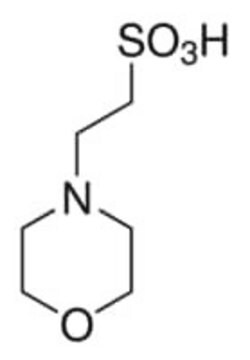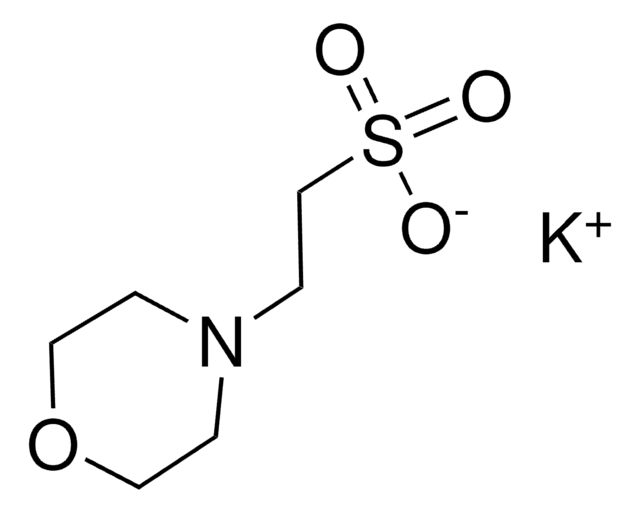M3058
MES sodium salt
BioPerformance Certified, suitable for cell culture
Sinónimos:
Ácido 2-(N-morfolino)etanosulfónico sodium salt, Ácido 4-morfolinoetanosulfónico sodium salt
About This Item
Productos recomendados
Nivel de calidad
grado
BioPerformance Certified
for molecular biology
formulario
crystalline powder
condiciones de almacenamiento
dry at room temperature
técnicas
cell culture | mammalian: suitable
impurezas
endotoxin and total aerobic microbial count, tested
color
white
intervalo de pH útil
5.5-6.7
pKa
6.1
solubilidad
water: 335.3 g/L at 20 °C
idoneidad
suitable for component for culture media
suitable for molecular biology
aplicaciones
agriculture
diagnostic assay manufacturing
life science and biopharma
sample preparation
actividad extraña
DNase, NICKase, RNase, protease, none detected
cadena SMILES
[Na+].[O-]S(=O)(=O)CCN1CCOCC1
InChI
1S/C6H13NO4S.Na/c8-12(9,10)6-3-7-1-4-11-5-2-7;/h1-6H2,(H,8,9,10);/q;+1/p-1
Clave InChI
IRHWMYKYLWNHTL-UHFFFAOYSA-M
¿Está buscando productos similares? Visita Guía de comparación de productos
Descripción general
Aplicación
Características y beneficios
- Suitable for Molecular Biology and Cell Culture
- Tested for Endotoxins and Total Aerobic Microbial Count
- Free from DNase, NICKase, RNase, and Protease
- Effective Buffering from pH 5.5-6.7 (25 °C) with a pKa of 6.1 (25 °C)
Nota de preparación
Otras notas
producto comparable
Código de clase de almacenamiento
11 - Combustible Solids
Clase de riesgo para el agua (WGK)
WGK 1
Punto de inflamabilidad (°F)
Not applicable
Punto de inflamabilidad (°C)
Not applicable
Equipo de protección personal
Eyeshields, Gloves, type N95 (US)
Certificados de análisis (COA)
Busque Certificados de análisis (COA) introduciendo el número de lote del producto. Los números de lote se encuentran en la etiqueta del producto después de las palabras «Lot» o «Batch»
¿Ya tiene este producto?
Encuentre la documentación para los productos que ha comprado recientemente en la Biblioteca de documentos.
Los clientes también vieron
Nuestro equipo de científicos tiene experiencia en todas las áreas de investigación: Ciencias de la vida, Ciencia de los materiales, Síntesis química, Cromatografía, Analítica y muchas otras.
Póngase en contacto con el Servicio técnico






